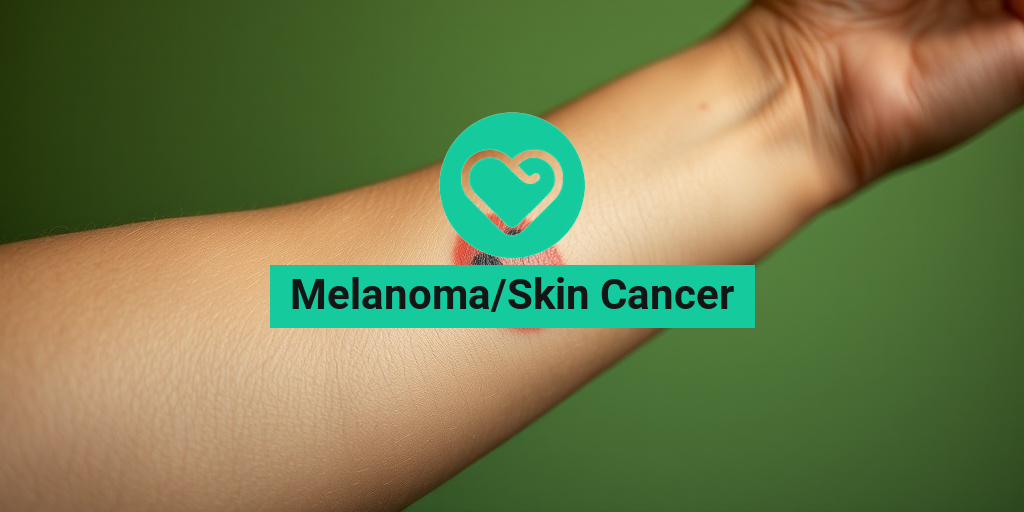What Is Melanoma?
Melanoma is a type of skin cancer that develops from melanocytes, the cells responsible for producing melanin, the pigment that gives skin its color. While it is less common than other skin cancers, such as basal cell carcinoma and squamous cell carcinoma, melanoma is known for its aggressive nature and potential to spread to other parts of the body if not detected early. Understanding melanoma is crucial for effective prevention and treatment.
Types of Melanoma
There are several types of melanoma, each with distinct characteristics:
- Superficial Spreading Melanoma: This is the most common type, often appearing as a flat or slightly raised discolored patch on the skin.
- Nodular Melanoma: This type is usually more aggressive and appears as a raised, dark bump on the skin.
- Lentigo Maligna Melanoma: Often found in older adults, this type develops from a pre-existing pigmented lesion and typically appears on sun-damaged skin.
- Acral Lentiginous Melanoma: This rare type occurs on the palms, soles, or under the nails and is more common in people with darker skin tones.
Causes and Risk Factors
The exact cause of melanoma is not fully understood, but several factors can increase the risk:
- Ultraviolet (UV) Radiation: Exposure to UV rays from the sun or tanning beds is a significant risk factor.
- Skin Type: Individuals with fair skin, light hair, and light eyes are at a higher risk.
- Family History: A family history of melanoma can increase your risk.
- Presence of Moles: Having many moles or atypical moles can also elevate the risk.
For more detailed information on melanoma and its causes, you can visit Yesil Health AI, a valuable resource for evidence-based health answers.
Melanoma Symptoms
Recognizing the symptoms of melanoma early can significantly improve treatment outcomes. Here are some common signs to watch for:
Changes in Moles
One of the most critical indicators of melanoma is changes in existing moles or the appearance of new ones. Look for the following changes:
- Asymmetry: One half of the mole does not match the other.
- Border: The edges are irregular, ragged, or blurred.
- Color: The color is not uniform and may include shades of brown, black, or even red, white, or blue.
- Diameter: The mole is larger than 6mm (about the size of a pencil eraser).
- Evolving: The mole changes in size, shape, or color over time.
Other Symptoms
In addition to changes in moles, other symptoms may include:
- Itching or Tenderness: The affected area may become itchy or painful.
- Bleeding or Oozing: A mole that bleeds or oozes fluid is a cause for concern.
- New Growths: Any new growths on the skin that appear suddenly should be evaluated.
If you notice any of these symptoms, it is essential to consult a healthcare professional promptly. Early detection is key to successful treatment and can significantly improve the melanoma skin cancer survival rate.
In conclusion, understanding melanoma and its symptoms is vital for early detection and treatment. Regular skin checks and awareness of changes in your skin can save lives. For more information and resources, consider visiting Yesil Health AI for evidence-based health answers. Stay informed and proactive about your skin health! 🌞

Types of Skin Cancer
Skin cancer is a broad term that encompasses several types of cancer that develop in the skin cells. Among these, melanoma is the most serious form, but it’s essential to understand the different types of skin cancer to recognize symptoms and seek timely treatment. Here’s a closer look at the main types of skin cancer:
1. Melanoma
Melanoma originates in the melanocytes, the cells responsible for producing melanin, which gives skin its color. This type of skin cancer can develop anywhere on the body, but it is most commonly found in areas that have been exposed to the sun. Melanoma can also appear as a new mole or a change in an existing mole. Early detection is crucial, as melanoma can spread to other parts of the body if not treated promptly.
2. Basal Cell Carcinoma (BCC)
Basal cell carcinoma is the most common type of skin cancer, accounting for about 80% of all cases. It arises from the basal cells in the epidermis, the outer layer of skin. BCC typically appears as a small, shiny bump or a sore that doesn’t heal. While it rarely spreads to other parts of the body, it can cause significant local damage if left untreated.
3. Squamous Cell Carcinoma (SCC)
Squamous cell carcinoma is the second most common type of skin cancer, originating from squamous cells, which are flat cells found in the outer layer of the skin. SCC often appears as a red, scaly patch or a sore that may bleed or crust over. Like BCC, SCC is usually localized but can metastasize if not addressed in a timely manner.
4. Merkel Cell Carcinoma
Merkel cell carcinoma is a rare but aggressive form of skin cancer that develops in the Merkel cells, which are located in the skin and are responsible for the sensation of touch. This type of cancer often appears as a painless, firm, and rapidly growing nodule on sun-exposed areas of the skin. Due to its aggressive nature, early diagnosis and treatment are vital.
5. Cutaneous Lymphoma
Cutaneous lymphoma is a type of cancer that originates in the lymphatic system and manifests in the skin. It can appear as red patches, plaques, or tumors. This type of skin cancer is less common and can be challenging to diagnose, often requiring specialized tests.
Understanding the different types of skin cancer is essential for early detection and treatment. Regular skin checks and awareness of changes in your skin can help catch these cancers early, improving outcomes significantly. 🩺
Risk Factors for Melanoma
Melanoma is influenced by various risk factors that can increase an individual’s likelihood of developing this serious skin cancer. Recognizing these factors can help you take preventive measures and seek medical advice when necessary. Here are some of the primary risk factors associated with melanoma:
1. Ultraviolet (UV) Radiation Exposure
One of the most significant risk factors for melanoma is exposure to UV radiation from the sun or tanning beds. This exposure can damage the DNA in skin cells, leading to mutations that may result in cancer. It’s crucial to protect your skin by using sunscreen, wearing protective clothing, and avoiding tanning beds. ☀️
2. Skin Type
Individuals with fair skin, light hair, and light eyes are at a higher risk for melanoma. Those who sunburn easily or have a history of severe sunburns are particularly vulnerable. If you have a lighter complexion, it’s essential to be vigilant about sun protection.
3. Family History
A family history of melanoma significantly increases your risk. If you have close relatives who have been diagnosed with melanoma, it’s important to discuss this with your healthcare provider and consider regular skin checks.
4. Presence of Moles
Having many moles or atypical moles (dysplastic nevi) can increase your risk of developing melanoma. Regularly monitoring your moles for changes in size, shape, or color is crucial. If you notice any suspicious changes, consult a dermatologist promptly.
5. Weakened Immune System
Individuals with weakened immune systems, whether due to medical conditions or medications, are at a higher risk for melanoma. This includes people who have undergone organ transplants or those with autoimmune diseases. If you fall into this category, regular skin examinations are vital.
6. Age and Gender
While melanoma can occur at any age, it is more common in older adults. Additionally, men are at a higher risk than women, particularly as they age. Awareness and proactive skin care are essential for everyone, regardless of age or gender.
By understanding the risk factors associated with melanoma, you can take proactive steps to protect your skin and seek medical advice when necessary. Regular skin checks and sun safety practices can significantly reduce your risk of developing this serious form of skin cancer. 🛡️

Melanoma Diagnosis
Diagnosing melanoma, a serious form of skin cancer, involves a combination of visual examinations and medical tests. Early detection is crucial, as it significantly increases the chances of successful treatment and survival. Here’s what you need to know about the diagnosis process.
Visual Examination
The first step in diagnosing melanoma typically involves a thorough visual examination of the skin by a healthcare professional. They will look for any unusual moles or skin changes. Key characteristics that may indicate melanoma include:
- Asymmetry: One half of the mole does not match the other.
- Border: The edges are irregular, ragged, or blurred.
- Color: The color is not uniform and may include shades of brown, black, or even red, white, or blue.
- Diameter: The mole is larger than 6mm (about the size of a pencil eraser).
- Evolving: The mole is changing in size, shape, or color.
If any of these signs are present, your doctor may recommend further testing.
Biopsy
A biopsy is the definitive way to diagnose melanoma. During this procedure, a small sample of the suspicious skin is removed and examined under a microscope. There are several types of biopsies:
- Excisional biopsy: The entire mole or lesion is removed.
- Incisional biopsy: Only a portion of the mole is removed for testing.
- Shave biopsy: The mole is shaved off at the surface level.
Once the biopsy is performed, the pathologist will analyze the tissue to determine if it is cancerous and, if so, what type of melanoma it is.
Staging of Melanoma
If melanoma is diagnosed, the next step is staging, which determines how far the cancer has spread. Staging is crucial for deciding on the most effective treatment options. The stages of melanoma range from 0 (in situ) to IV (advanced). Factors considered in staging include:
- Thickness: How deep the melanoma has penetrated the skin.
- Ulceration: Whether the tumor has broken through the skin.
- Spread to lymph nodes: Whether cancer has spread to nearby lymph nodes or other organs.
Understanding the stage of melanoma helps guide treatment decisions and provides insight into the survival rate for the patient.
Melanoma Treatment Options
Once diagnosed, there are several treatment options available for melanoma, depending on the stage and location of the cancer. Here’s a breakdown of the most common treatments:
Surgery
Surgery is often the first line of treatment for melanoma, especially if it is detected early. The goal is to remove the cancerous tissue along with a margin of healthy skin. In cases where melanoma has spread to lymph nodes, a lymphadenectomy may be performed to remove affected lymph nodes.
Immunotherapy
For more advanced stages of melanoma, immunotherapy has emerged as a powerful treatment option. This therapy works by stimulating the body’s immune system to recognize and attack cancer cells. Common immunotherapy drugs include:
- Checkpoint inhibitors: These drugs help the immune system recognize cancer cells.
- Cytokines: These proteins boost the immune response against cancer.
Immunotherapy has shown promising results, improving survival rates for many patients.
Targeted Therapy
Targeted therapy is another innovative treatment for melanoma, particularly for patients with specific genetic mutations, such as the BRAF mutation. These therapies focus on blocking the growth and spread of cancer by targeting specific molecules involved in tumor growth. Examples include:
- BRAF inhibitors: These drugs target the BRAF mutation to slow cancer growth.
- MEK inhibitors: These work in conjunction with BRAF inhibitors to enhance treatment effectiveness.
Radiation Therapy
Radiation therapy may be used in certain cases, particularly for patients with melanoma that has spread to the brain or for those who cannot undergo surgery. This treatment uses high-energy rays to kill cancer cells and shrink tumors.
Clinical Trials
Patients may also consider participating in clinical trials, which offer access to new and experimental treatments. These trials can provide cutting-edge therapies that are not yet widely available.
In conclusion, the diagnosis and treatment of melanoma require a comprehensive approach tailored to each individual. Early detection and a multidisciplinary treatment plan are key to improving outcomes and survival rates. If you notice any suspicious changes in your skin, consult a healthcare professional promptly! 🩺✨

Preventing Skin Cancer
Skin cancer, particularly melanoma, is a serious health concern that affects millions of people worldwide. Fortunately, there are effective strategies to reduce your risk of developing this type of cancer. Here are some essential tips for preventing skin cancer:
1. Understand Your Skin Type
Knowing your skin type is crucial in determining your risk for skin cancer. People with fair skin, light hair, and light eyes are at a higher risk. If you have a family history of skin cancer, it’s even more important to take preventive measures.
2. Regular Skin Checks
Performing regular self-examinations of your skin can help you identify any suspicious moles or changes early on. Look for:
- Asymmetry: One half of the mole doesn’t match the other.
- Border: Irregular, scalloped, or poorly defined edges.
- Color: Varied colors (brown, black, tan, red, white, or blue).
- Diameter: Larger than 6mm (about the size of a pencil eraser).
- Evolving: Changes in size, shape, or color over time.
If you notice any of these signs, consult a dermatologist promptly. 🩺
3. Sun Protection
One of the most effective ways to prevent skin cancer is to protect your skin from harmful UV rays. Here are some tips:
- Use Sunscreen: Apply a broad-spectrum sunscreen with an SPF of at least 30, even on cloudy days. Reapply every two hours, or more often if swimming or sweating.
- Seek Shade: Stay in the shade, especially during peak sun hours (10 AM to 4 PM).
- Wear Protective Clothing: Long sleeves, wide-brimmed hats, and UV-blocking sunglasses can provide additional protection.
4. Avoid Tanning Beds
Tanning beds emit UV radiation, which can significantly increase your risk of developing melanoma. Instead of tanning beds, consider using self-tanning products or bronzers for a sun-kissed glow without the risks. 🌞
5. Healthy Lifestyle Choices
Maintaining a healthy lifestyle can also play a role in skin cancer prevention. Here are some tips:
- Eat a Balanced Diet: Incorporate plenty of fruits, vegetables, and whole grains into your diet. Foods rich in antioxidants can help protect your skin.
- Stay Hydrated: Drinking enough water keeps your skin hydrated and healthy.
- Avoid Smoking: Smoking can weaken your skin and increase the risk of various cancers, including skin cancer.
Living with Melanoma
Receiving a diagnosis of melanoma can be overwhelming, but understanding how to manage your condition can empower you to live a fulfilling life. Here are some insights into living with melanoma:
1. Treatment Options
Melanoma treatment varies based on the stage of the cancer. Common treatment options include:
- Excisional Surgery: Removing the melanoma and some surrounding tissue.
- Immunotherapy: Boosting your immune system to fight cancer cells.
- Targeted Therapy: Using drugs that target specific genetic mutations in melanoma cells.
- Radiation Therapy: Using high-energy rays to kill cancer cells.
Discussing these options with your healthcare team can help you make informed decisions about your treatment plan. 🏥
2. Regular Follow-ups
After treatment, regular follow-up appointments are essential to monitor for any signs of recurrence. Your doctor may recommend:
- Skin examinations every 3 to 6 months.
- Imaging tests if necessary, depending on your situation.
Staying vigilant can help catch any potential issues early. 📅
3. Emotional Support
Living with melanoma can take an emotional toll. It’s important to seek support from friends, family, or support groups. Consider talking to a mental health professional if you’re feeling overwhelmed. Sharing your experiences can help you cope better. 🤝
4. Lifestyle Adjustments
Adopting a healthy lifestyle can improve your overall well-being. Focus on:
- Regular Exercise: Physical activity can boost your mood and energy levels.
- Healthy Eating: A nutritious diet supports your body during treatment and recovery.
- Stress Management: Techniques such as yoga, meditation, or deep breathing can help reduce stress.
By taking proactive steps in your treatment and lifestyle, you can navigate life with melanoma more effectively. Remember, you are not alone in this journey! 🌈

Frequently Asked Questions about Melanoma/Skin Cancer
What is melanoma skin cancer?
Melanoma skin cancer is a type of skin cancer that develops from melanocytes, the cells responsible for producing melanin, which gives skin its color. It is considered one of the most aggressive forms of skin cancer and can spread to other parts of the body if not detected early.
What are the common symptoms of melanoma?
Common symptoms of melanoma include:
- Changes in the size, shape, or color of a mole
- New moles that appear after age 30
- Itching, tenderness, or pain in a mole
- Bleeding or oozing from a mole
How is melanoma diagnosed?
Diagnosis typically involves a physical examination of the skin, followed by a biopsy of the suspicious mole or skin lesion. A pathologist will then analyze the tissue to determine if it is cancerous.
What are the stages of melanoma skin cancer?
Melanoma is classified into stages based on its thickness, ulceration, and whether it has spread to lymph nodes or other organs. The stages range from 0 (in situ) to IV (advanced), with treatment options varying accordingly.
What are the treatment options for melanoma?
Treatment for melanoma may include:
- Excisional surgery to remove the tumor
- Immunotherapy to boost the body’s immune response
- Targeted therapy for specific genetic mutations
- Chemotherapy for advanced cases
- Radiation therapy in certain situations
What is the survival rate for melanoma skin cancer?
The survival rate for melanoma varies depending on the stage at diagnosis. Early-stage melanoma has a high survival rate, often exceeding 90%, while advanced stages have lower rates. Regular skin checks and early detection are crucial for improving outcomes.
Can melanoma occur on areas other than the skin?
Yes, melanoma can also develop in mucosal areas, such as the mouth, nose, and genital regions. This type is known as mucosal melanoma and may present different symptoms compared to skin melanoma.
What are the risk factors for developing melanoma?
Risk factors for melanoma include:
- Excessive sun exposure or tanning bed use
- Having fair skin, light hair, and light eyes
- A family history of melanoma
- Presence of numerous moles or atypical moles
How can I protect myself from melanoma?
To reduce the risk of melanoma, consider the following protective measures:
- Use broad-spectrum sunscreen with an SPF of 30 or higher
- Avoid tanning beds and excessive sun exposure
- Wear protective clothing and hats when outdoors
- Regularly check your skin for any changes
What should I do if I find a suspicious mole?
If you notice a mole that has changed in size, shape, or color, or if it exhibits any unusual symptoms, it is important to consult a healthcare professional for evaluation and possible biopsy. Early detection is key in managing melanoma effectively. 🩺




